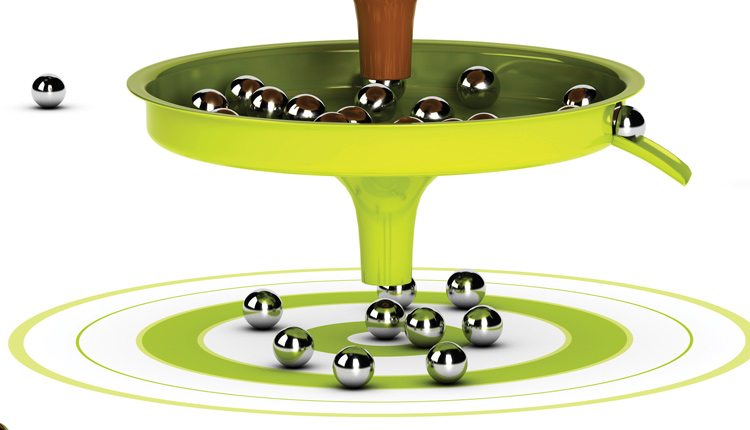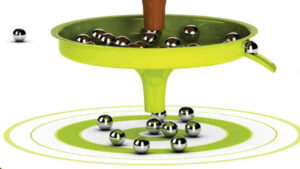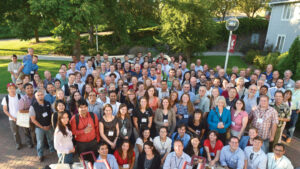The short-term nature of breeding pushes genetic resources out of today’s hybrids.
In the early years of agriculture, humans found plants with desirable characteristics, such as higher yield and more seeds, and used seeds from those plants for the next year’s crop.
Since then, breeding and selection has become more complex, but one of the results is the same. Each time plants with superior traits are kept or crossed with each other, favorable genes are preserved and some other genes are lost.
That means today’s superior crop hybrids draw from a constantly narrowing genetic pool — a concern for some breeders such as Rex Bernardo, professor and endowed chair in corn breeding and genetics at the University of Minnesota.
“We cross good lines with good lines in the hopes of getting better lines, but that means we discard other genes and don’t always know what those genes do,” says Bernardo, who gave the keynote speech, “Philosophy and Practice of Utilizing Genetic Diversity in Plant Breeding” at the 2015 annual meeting of the National Association of Plant Breeders. “We need to push grain yields more and more as the world’s population grows, and we need genetic diversity to do that.”
Bernardo argues that by systematically reducing genetic diversity in our crop species, breeders have tied themselves to the short term where diseases, new pest pressures and tolerance to changing climate have to be dealt with as if putting out fires.
Breeders are pressured to deliver new and better lines to the market each year, and intense selection in those plants makes increasing or even maintaining genetic diversity difficult. Bringing landraces or wild-type plants, or even others that simply are not near the more superior parent lines available, dilutes the likelihood that a new hybrid will meet the needs of commercial entities and growers.
“In a way, we’ve become victims of our own success,” he says. “We’ve made it difficult to get out of the germplasm groups that we know work so well.”
Say a breeder has two parent plants, Bernardo says, and the target trait is controlled by 100 genes. If one parent has 50 beneficial genes and the other parent has the other 50 beneficial genes, crossing these two parents gives the average offspring a mix of 50 good genes. While the average is 50, many progeny will have less than 50 good genes and many progeny will have more than 50 good genes. Selecting progeny with more than 50 good genes would lead to improvement over either parent.
But if a breeder is trying to increase genetic diversity and crosses an elite parent with 70 beneficial genes with a diverse but less-adapted parent that has only 30 beneficial genes, the likelihood of a superior line becomes very small.
“When you make that cross, you wind up with a mean of only 50 good genes, which is less than that in the elite parent you’re trying to improve. The odds are stacked against getting a line with more than 70 good genes,” Bernardo says. “It’s just the way the numbers and chance work. Unless you can do that faster, you’re playing catchup all the time.”
The other side of the coin is that breeders who aren’t able or willing to play catchup all the time are breeding out genetic resources that aren’t fully understood and could be helpful.
“There could be genes out there that might have been discarded and genes out there that may be useful, but occur infrequently,” Bernardo says.
Those genes haven’t been lost. Seeds are stored at facilities around the world where they are used for research or stored so they can be accessed by scientists if the need arises. The so-called “doomsday vault,” the Svalbard Global Seed Vault in the Arctic, just 800 miles from the North Pole, recently pulled out a portion of its stores that had been sent to the vault from Aleppo, Syria.
But those retrieved seeds had to be recovered because the working repository has been destroyed in the civil war ravaging in Syria. Other seedbanks have also been lost to wars or natural disasters, and it’s possible that seeds — and genetic resources — not backed up in places like Svalbard could be forever lost.
“In a way, we’ve become victims of our own successes. We’ve made it difficult to get out of the germplasm groups that we know work so well.”
— Rex Bernardo
Offense and Defense
In the short term, Bernardo says, plant breeders can play defense against new pests, diseases and other plant pressures. It is possible to take a known gene that can confer resistance for the plant and use parents with those traits to develop resistant hybrids. But it’s possible that there are unknown genes in a wild type of plant that could protect against a disease or pest that hasn’t become a problem yet. Finding and adding those genes into the germplasm would be a costly and time-intensive process.
“If we know what those genes are, then we can select for those genes,” Bernardo says. “But there is a whole suite of unknown genes out there.”
On the offensive side, plant breeders are constantly trying to increase yields to feed a growing population or biomass to increase the amount of energy that can be drawn from plants for biofuels. In those cases, it is often not just one gene that controls a plant’s size or grain yield, but a host of them that can give incremental increases or work in concert to boost the plant’s potential.
It’s those cases, Bernardo says, where the most potential could be lost by narrowing the genetic diversity of crops. Unless and until breeders and other scientists see what those unused genes can do, their potential value is wasted.
Funding
Seth Murray, an associate professor and Eugene Butler endowed chair in the Department of Soil and Crop Sciences at Texas A&M University, believes genetic diversity is an issue that breeders should keep an eye on as well.
However, he thinks that as needs for genetic resources have arisen — at least for short-term problems — industry has risen to the occasion.
“It’s a story I was taught and a story that needs to be told,” Murray says. “The need is no more urgent than it has been during the past 30 years.”
The more pressing issue, as Murray sees it, is that there is little money available to expand genetic diversity for the long-term.
“Breeding is inherently slow and unfortunately inherently reactionary,” Murray says. “There’s just such a tiny amount of money spent on these things, and that’s the bigger problem. If we don’t have the research and development money, we tend to focus on the reactionary problems.
“The problem with that type of research is there is no distinct commercialized product. If it doesn’t support publications or new cultivars in five years, there’s no money for it.”
Jesse Poland is an assistant professor at Kansas State University and associate director of the Wheat Genetics Resource Center, as well as director of the Feed the Future Innovation Lab for Applied Wheat Genomics. He agrees that funding is a significant hurdle to overcome.
The commercial sector could benefit from investment in the research and breeding to increase genetic diversity, Poland says, but it’s unlikely since it could take decades to see a return on that investment.
“You run into this 10- and 20-year process of identifying and utilizing the favorable diversity, but you have an increasingly commercially dominated landscape where the hybrids are coming from entities who answer to investors who have a one-, two- or five-year outlook,” Poland says. “Adding variation might not be good at delivering a profit into the near term, even if that is what will sustain gains in the long-term.”
Poland is not sure the reactionary approach many breeders and industry take is going to change because the alternative is a blind grab at genes without a known value. That is too risky in a commercial landscape. It’s possible that an up-to-now discarded gene could protect against a future disease, but breeders can’t predict that.
“You’re really talking about pre-emptive breeding for an unknown future,” Poland says. “It’s hard to know what we don’t know.”
Other Solutions
Murray says it would take significant effort from the public sector, most likely, to have a major push toward genetic diversity. “It’s the role of the public sector, but we’re losing so many breeders in the public sector that we’re really setting ourselves up for a food security problem,” he says.
Murray says that despite there being tens of thousands of plant species that humans could consume, we rely on just a few dozen for the vast majority of our diets. If that changes, he says, genetic diversity would be less of a pressing concern because one crop’s failure would not be the catastrophic issue it would be today.
“Maybe we need to look at more crops. We continue to put more dependence on fewer and fewer crops,” Murray says. “To change that system, breeders have to be involved.”
Bernardo says another solution could be in germplasm exchanges or licensing agreements. The genes found in superior corn hybrids in the United States, for example, likely differ from the genes found in superior hybrids in other parts of the world. “Many breeding organizations have become worldwide in nature and they have access to germplasm they wouldn’t have had before,” Bernardo says. “Instead of looking at wild types, there may be solutions in these other elite lines.”












